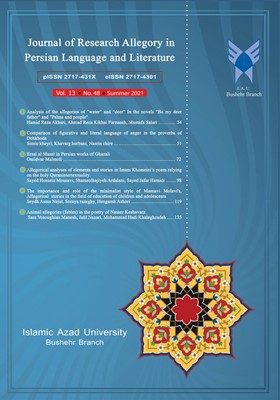The importance and role of the minimalist style of Masnavi Molavi's, Allegorical stories in the field of education of children and adolescents
Subject Areas : Research Allegory in Persian Language and Literatureseydh asma nejat 1 , Soraya razeghy 2 , Hengamh Ashori 3
1 - Ph.d student of Persian literature and language Azad university North Tehran Branch, Faculty of humanities, Azad university NorthTehran Branch
2 - Assistant Professor, Department of Persian Language and Literature, Azad University, North Tehran Branch
3 - Assistant Professor, Department of Persian Language and Literature, Azad University, North Tehran Branch
Keywords:
Abstract :
Minimalism an art style that is the basis of your work Based on simplicity of expression and themes devoid of philosophical complexity or quasi-philosophical has established. The authors of this style believe that saving in words and shorthand, It causes beauty and increases the effect of words and rhetoric. The best examples of minimalism in classical Iranian literature for example, in the book of Rumi's Masnavi and its allegorical stories can be found. What can be said is whether the minimalist stories of Rumi's Masnavi can be fruitful and used in the field of education? The research method in this research is descriptive-analytical. The purpose of this study is to investigate the minimalism style of Masnavi allegorical stories in the field of children's education.The results show that by examining the Masnavi stories, many of the features and characteristics of minimal stories can be seen in them and on the other hand, due to the educational nature of Rumi's Masnavi book and given the cognitive limitations of children, minimalist Masnavi Stories is the best platform for expressing the educational , moral and social teachings of children and adolescents. Because long words and stories are not suitable for children and teenagers and does not fit into their capacity and it reduces its educational aspects. In children's literature that tends to simplify and make the stories real for objectification of the story space with the child's mentality, inevitably, short writing is essential and writers in this field are interested in using minimalist expression to convey their educational and training concepts to children. In this study, the author uses elements that are used to a minimum has been studied in Masnavi and also educational messages has found and analyzed stories that have common elements.
_||_


